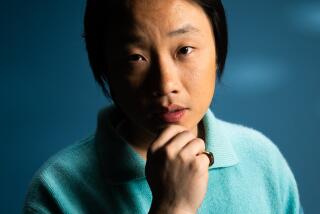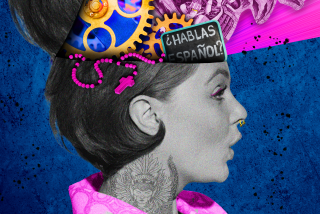Vantage Point : A painter and storyteller relates her father’s childhood in China : BABA: A Return to China Upon My Father’s Shoulders, <i> By Belle Yang (Harcourt Brace: $27.95; 240 pp.)</i>
The cover of “Baba” fills your eye with splashes of vibrant color and an explosion of Chinese folk figures and symbols, above which rests the book’s evocative image of the author perched upon her father’s shoulders to revisit the events of his childhood. Before you have even opened Belle Yang’s captivating memoir of a China that now seems so remote, you are hooked.
Yang, who emigrated from Taiwan to America as a child in the 1960s, grew up to become an artist, following in the footsteps of her father; over the intervening years he entertained her with tales of life in Northeast China of the 1930s and 1940s, a place and time tantalizingly beyond her reach. Wanting to share those memories more intimately and draw closer to her father, she knew she would have “to tap into the original language in which his ideas were given form.” So she went to China and spent three years studying art at Beijing’s Academy of Traditional Chinese Painting, learning spoken and written Chinese, and traveling around the vast landscape. Upon her return to America in 1989, in the wake of the horrors of Tian An Men Square, she was finally able to “ask the questions that would stir (her father) enough to carry (her) into the past.” Baba is the glorious result of these two interwoven journeys, taken half a century apart.
Born the fourth of seven children in a prominent, sprawling family transplanted generations earlier from south of the Great Wall to the Manchurian steppes, Joseph Yang--Baba--was submerged in the rituals of traditional Chinese life, with its rigid hierarchies, weighty Confucian morality and collective ethos. In 1931, when he was 3 years old, the more familiar predators--bandits, warlords, and a host of fanciful charlatans--were replaced by the most voracious plunderers of all, the Japanese Imperial forces; they occupied Manchuria and set up the puppet state of Manchukuo.
Yang’s text is rich in humanity, with healers, wastrels, beggars, goblins, family members as perplexing as they are endearing, even a living Buddha (slightly tarnished). The people in these tales occupy themselves with births and deaths and weddings and errant train rides; with posturing and saving face and making stupid life decisions. These are folk tales grounded securely in reality, ghost stories with human twists and recaptured moments that are often painful to narrator and reader alike.
Lavishy illustrated and lovingly narrated, Baba wonderfully evokes the sights, sounds and emotions of a lost childhood. The influence of folk art on Yang is strikingly obvious in the two dozen sparkling watercolors that illuminate the text; yet it is to her credit as a writer that while readers may well come for the wonderful paintings, they will stay for the prose. There are wonderful descriptions, where all share in the rewards of Yang’s wordsmithing, even the ugly daughter of a medicine man with miraculous curative powers:
“Daye being rather a progressive thinker (and having no other choice), his hope came to rest upon his other child--a daughter. Now, this daughter--a short, squat, swarthy woman with bulbous eyes and yellow, rat-like teeth that sprouted between her normal adult ones, leaning every which way like disrupted roof tiles--was so homely, she aroused pity and brought silent condolences to people’s lips.”
Or the depiction of the mysterious, soup-slurping hanger-on who sees the past and the future with equal clarity:
“Idiot Yuan wore a silk skullcap atop a spray of long hair that was cut bluntly at the shoulders--hair so black it absorbed all light. He sniffled and snuffled, fluid always threatening to slide out of his nose and down his stringy beard. His big, bloodshot eyes were shaded by protrusive brow ridges, above which vertical veins, like two purple cords, throbbed. The man was poor in expressions, hanging only one upon his swarthy face: that of a foolish half-smile.”
Yang routinely brings such images to life with her ability to choose words as colors and create sentences that flow like brush strokes. The filtering process of the tales--from father to daughter to reader--produces a remarkable clarity of vision and insistent narrative continuity; then each event or theme is captured in crystalline permanence by Yang’s artwork. Whenever I searched the paintings for something I might have missed (which was often), I was led back to the text from which it emerged: to bottles in the sky (those curious, and deadly, Japanese bombs), or table scraps (gathered by an aging peasant couple), or the “firewagon” (on which village women take an unanticipated joy ride), or a set of four quite different weddings and a funeral.).
Yang moves effortlessly from the role of mediator of her father’s memory voice to that of interpreter of contexts and consequences. And she holds out the promise of a continuation of her father’s passage through China, for the book ends as he prepares for a journey south to escape the ruthless search for “enemies of the people” by the newly arrived Communist forces. While waiting to see where Baba goes next, his daughter “riding high upon his shoulders to dream the landscape of China,” the reader can return to the words and pictures of this remarkable book. I know I will.
More to Read
Sign up for our Book Club newsletter
Get the latest news, events and more from the Los Angeles Times Book Club, and help us get L.A. reading and talking.
You may occasionally receive promotional content from the Los Angeles Times.







